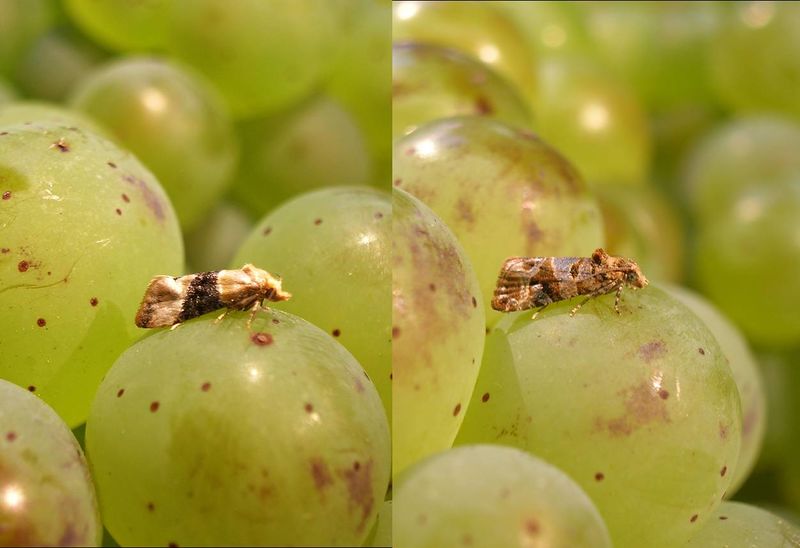Pest
European grape berry moth & grapevine moth

On the left: European grape berry moth, on the right: Grapevine Moth (Photo: Ursula Hetterling, www.vitipendium.de)
| Überblick | |
|---|---|
| Latin name | Eupoecilia ambiguella / Lobesia botrana |
| Host Plants |
European grape berry moth: wild vine, clematis, wood grape, privet, etc. Grapevine moth: plants in warmer regions such as daphne, Judendorn, rosemary, olive |
| Appearance |
European grape berry moth: the forewings of the moth are straw yellow with a brown-black cross-band. The body length is 6-8 mm. The caterpillar is reddish brown and has a black head capsule. It is 10 - 12 mm long. Grapevine moth: the forewings of the moth are colorfully marbled from yellow to green to gray. The body length is 5 - 7 mm. The caterpillar is green-grey, the head is yellow. It is 8-10 mm long. |
| Time of Infestation |
1st generation: April/May - June 2nd generation: July – August |

On the left: European grape berry moth, on the right: Grapevine Moth (Photo: Ursula Hetterling, www.vitipendium.de)
- Damage
- Evolution of the Pest
- Infestation Control
The European grape berry moth & grapevine moth are one of the most important pests in viticulture. The larvae of the first generation influence the development of the flowers by feeding on the leaves and laying webs on them. The larvae of the second generation eat on and in the growing fruits and thus interrupt their development. Secondary parasites such as grey or green rot can occur at the boreholes and feeding sites and cause immense economic damage.
The flight activity of the moths starts in April/ May. The European grape berry moth is nocturnal and flies until the morning hours. The grapevine moth is active at dusk.
The females deposit their eggs on the flowers on the plots. At the beginning of June the larvae hatch, feeding on the flowers until they pupate at the end of June.
The females of the second generation lay their eggs on the berries in July. The larvae hatch, bore into the fruits and feed until they pupate under the bark in August.
During a long and warm summer, a third generation of the grapevine moth may appear, which also deposits its eggs on the berries at the end of September.
Monitoring the Development of European Grape Berry Moth & Grapevine Moth with TRIPHERON®-Traps
The beginning of the flight activity of the moths can be detected by pheromone traps. Pheromone traps intercept the male moths and can thus partially reduce the fertilization of the females and thus the deposit of eggs. They should be hung up in the outer crown of the trees from the end of April. At the beginning of the flight activity, the beginning of larval hatching and thus the necessary treatment time can be calculated.